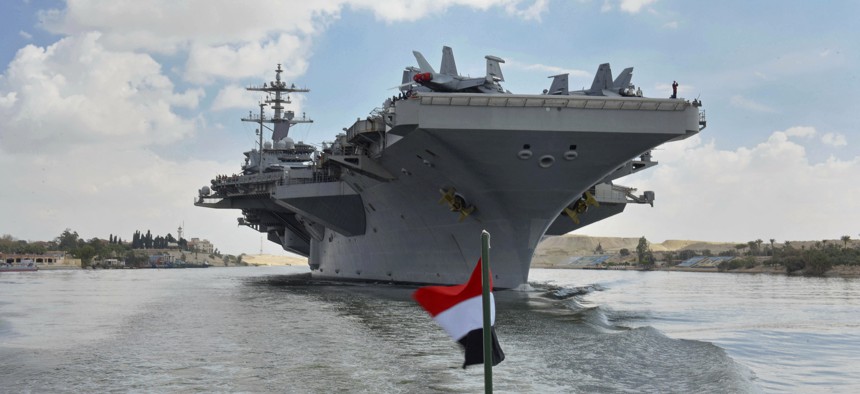
The USS Abraham Lincoln sails south in the Suez canal near Ismailia, Thursday, May 9, 2019. Suez Canal Authority via AP
US To Send 900 Troops To Middle East To Counter Iran
The Trump administration insists that the deployment is purely defensive.
The Trump administration is sending about 900 additional troops to the Middle East in what senior defense officials insisted Friday is a “narrowly-focused defensive posture” intended to protect U.S. troops from Iran without provoking a wider conflict.
“We think that through a combination of a very measured deployment of assets as well as public messaging, we are again trying to underscore that we are not seeking hostilities with Iran,” said Joint Staff Director Rear Adm. Michael Gilday. “In the military dimension, that is the best we can do — because they are reacting in the military dimension.”
“We just want to be clear that based on our posture and the assets we are flowing to theater, [U.S. posture] is not in any way designed to be provocative.”
The deployment will include 900 fresh troops, including an Air Force fighter squadron, to allow the Pentagon to respond to any attacks, gather intelligence on Iran and its proxies, and harden its existing defenses. One Patriot missile defense battalion — which includes about 600 troops — already in the region will also be extended.
Pentagon officials declined to say where the troops would be sent. Acting Assistant Secretary of Defense for International Security Affairs Katie Wheelbarger told reporters Friday only that they would not go to Iraq or Syria. The U.S. currently has about 70,000 troops across all domains in the Middle East.
President Trump notified Congress of the deployment on Friday.
The deployment comes amid ongoing skepticism on Capitol Hill over the Trump administration’s claims of new intelligence that has thrust heightened tensions between the U.S. and Iran into public view over the past two weeks. On May 5, National Security Advisor John Bolton announced that the Defense Department was positioning a carrier strike group to the region to respond to what Defense Department officials later said was a credible threat from Tehran on U.S. forces in the region. Since then, defense officials have attributed a number of attacks on U.S. partners in Saudi Arabia and off the coast of the U.A.E. to Iran-aligned groups and proxies that Gilday said Friday were directed by Tehran.
Administration and military officials have provided no evidence to back up their intelligence claims, drawing unfavorable comparisons to the lead-up to the Iraq War in 2003 from critics and veterans of that conflict. Republican lawmakers have backed up the Trump administration’s assessment of a credible threat to U.S. troops in the region, and blocked a Democratic measure to curb Trump’s powers to send forces. Democratic lawmakers who have also been briefed say the administration is inflating the threat in order to make the case for war with Iran. The Pentagon’s three-star Joint Staff director rejected that theory, on Friday.
“This truly is operations-driven by intelligence,” Gilday said. The DOD assesses with a “high degree of confidence” that Iran was behind “all” of the recent attacks, he said — including a drone attack on an oil pipeline in Saudi Arabia claimed by Houthi rebels with murky ties to Iran; an attack on two oil tankers off the coast of Fujairah in the UAE; and a rocket that landed near the U.S. embassy in Baghdad. Iran also attempted the “covert deployment of modified dhows capable of launching cruise missiles,” Gilday said.
“We view this as a campaign,” he said. “I think that it does have a degree of complicated nature to it in terms of tying a bunch of threads together. We see this differently than just an episodic errant rocket here and there.”
While Trump adminsitration officials have made threats from Iran a central focus of its Middle East policies and messaging, senior military officials for more than a year have also tried to sound alarms about Iran’s proliferation of ballistic missiles, suicide drones, and IED boats, especially in and around Yemen. Military and administration officials have repeatedly insisted in the past two weeks that this recent request for troops came up the chain from regional command, rebuffing theories it was a Bolton-hatched plot. The request for additional troops came from newly-installed U.S. Central Command head Gen. Ken McKenzie, Gidlay said.
Democratic lawmakers briefed on the underlying intelligence on Wednesday were not satisfied.
“The intent of this administration for quite some time — people like John Bolton, people like [Secretary of State] Mike Pompeo — have a long history of calling for regime change in Iran and wanting to go to war in Iran,” House Armed Services Committee member Rep. Tulsi Gabbard, D-Hawaii, who is also running for president, said Wednesday.
“This is the concern that many of us have, knowing that has been a stated intent. Even though the administration is saying they have no desire to go to war with Iran, their actions tell a very different story.”
On Friday, the committee’s top Republican, Rep. Mac Thornberry, of Texas, said in a statement, “The forces being deployed are in response to a request from CENTCOM. I understand that there is a temptation to view everything through a political lens, but a request from a commander on the ground for additional force protection should never be subject to a partisan debate. This is a prudent step to protect our forces and deter Iran.”
Trump publicly has been ambivalent about military engagements in the Middle East since his 2016 campaign, pledging to return U.S. troops from long wars in Syria, Iraq, and Afghanistan while encouraging regional powers to do more of their own fighting. On Monday, Trump in a tweet threatened “the official end of Iran” if they “want a fight.” But in the past two weeks, he has stated repeatedly he does not want war and wants regime leaders to “call” him.
Lawmakers briefed this week by Acting Defense Secretary Pat Shanahan and Joint Chiefs Chairman Gen. Joseph Dunford have raised questions about the Trump administration’s broader policy for dealing with Iran. Tensions between the two countries have been rising since Trump pulled out of the Iran nuclear deal last year, which traded sanctions relief for certain curbs on the regime’s nuclear weapons program. Republicans have long derided the deal as too narrow in scope and have kept Iran as a central focus of their national security policy. Pompeo and Bolton, in particular, long have been proponents of a harsher approach to Iran.
“They didn’t tell us how they were planning to get them to talk,” Sen. Chris Murphy, D-Conn, said following Wednesday’s briefing. “It just seems to be a process of blind escalation with the hopes that the Iranians will come to their senses at some point.”
Wheelbarger pushed back on that characterization on Friday.
“We have attempted to be very clear with Congress that our policy objective remains to return Iran to the negotiating table to address more than just their nuclear program, but to address the range of their destabilizing behavior across the region,” Wheelbarger said. Twelve demands on Iran’s behavior made by Pompeo last year “is the most concrete example of the issues that we want to address in that comprehensive deal with Iran,” she said.
“I want to make clear that our policy with regards to Iran has not changed.”




